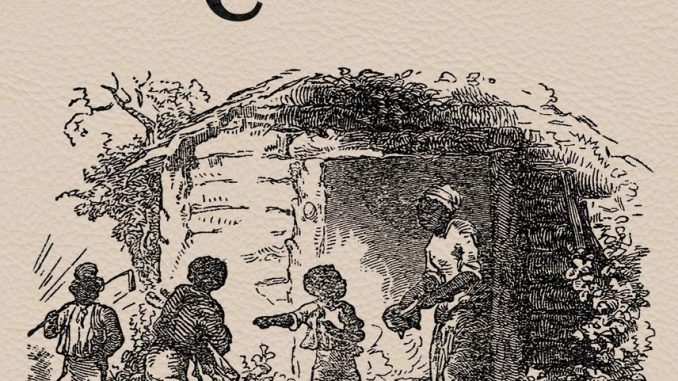
 ‘Uncle Tom’s Cabin: or, Life Among the Lowly’ was published in 2 parts in 1852. The abolitionist movement was gaining ground and Stowe wrote the novel in the wake of the 1850 Fugitive Slave Law, which provided for the return of enslaved people who escaped from one state into another state and made assisting escapees illegal. She wanted to show the harsh reality of slavery and that it could be overcome by Christian love.
‘Uncle Tom’s Cabin: or, Life Among the Lowly’ was published in 2 parts in 1852. The abolitionist movement was gaining ground and Stowe wrote the novel in the wake of the 1850 Fugitive Slave Law, which provided for the return of enslaved people who escaped from one state into another state and made assisting escapees illegal. She wanted to show the harsh reality of slavery and that it could be overcome by Christian love.
The novel has, at least since the 20th century been linked with reinforcing some negative racial stereotypes. The title character came to be associated with an excessively subservient person. Louis Armstrong was often accused of being an “Uncle Tom”, notably by Miles Davis and other younger jazz musicians, who while respecting his musical genius, saw his interactions with influential white people as submissive. The truth, of course, was more complex than that, but the association of Stowe’s novel with condescension and passive acceptance of slavery have undermined its role in the 1850s and later as a “vital antislavery tool”. Recent scholarship has revived the reputation of the book somewhat.
The plot starts with slave owner Arthur Shelby planning to sell two slaves to stave off his debts. Uncle Tom is to be sold away from his wife and family, along with Harry, the son of Shelby’s wife’s beloved maid Eliza. The callousness of the slave trade highlighted by the ease with which families are broken up is one of the key messages of the early part of the book. Eliza chooses to run away with her son, and Tom is sent to a slave market. While there he saves a white girl, Eva from drowning and is bought by her father as an “act of gratitude.” Tom and Eva share a deep Christian faith, and build a connection based on it. Tom is sold on once again, which does rather undermine the message of Christian charity that Stowe is depicting. That message is also focused in the tale of Eliza’s escape. She is tracked down by the Slave Hunters who were a big part of enforcing the Fugitive Slave Laws, Loker the Slave Hunter is shot, but Eliza takes him to a Quaker mission as another act of Christian charity. Changed by the experience Loker helps Eliza and her family escape to Canada. Tom’s faith is tested by his new owner, a vicious planter named Simon Legree. Tom is beaten to death after defying Legree, but forgives the men who beat him, humbling them into becoming Christians.
The impact of he book at the time was huge. The phrase “sold down the river” originates with it, from Tom being sold to a New Orleans trader, down the Mississippi. ‘Uncle Tom’s Cabin’ has been credited with focusing Northern anger at the injustices of slavery and the Fugitive Slave Law. Frederick Douglass, an escaped slave who became a prominent social reformer, writer and, statesman, said of the novel that it was: “a work of marvellous depth and power.” He was “convinced both of the social uses of the novel and of Stowe’s humanitarianism.” In the Southern States reaction centered on claims that it was an untrue depiction of the life of enslaved people. In 1853 Stowe published ‘A Key to Uncle Tom’s Cabin’, which documented each of the major characters in Uncle Tom’s Cabin and cites “real life equivalents” to them while also mounting a more “aggressive attack on slavery in the South than the novel itself had”
In the last few years, and in the light of the “Black Lives Matter” movement the harsher criticism of the novel has been tempered. The writer Sadia Rahman in a June 2020 article for Business Standard covered the main areas of current thought about Uncle Tom’s Cabin. She says, writing in the early days of the Pandemic and in the aftermath of the killing of George Floyd, that: “To understand the current protests… and their demands, rage, and frustration, we must enlighten ourselves with historical knowledge. And Uncle Tom’s Cabin is an excellent recommendation.” And: “During the 20th and 21st century, the character of Uncle Tom has been represented as cowardly for remaining silent and enduring mistreatment at the hands of his white masters. But I felt the portrayal was probably necessary two centuries ago to arouse the masses’ sentiments against white barbarity.”
Writing on the 209th anniversary of Stowe’s birth Rahman paid “tribute to her courage for being vocal on behalf of the oppressed, on voicing what is right centuries ago – something many of us are afraid to do even now.”
Uncle Tom’s Cabin is available to buy in paperback form but also through the Project Gutenberg library of free public domain books. When I told a friend, who is a prominent member of the Black Community in Bristol, that I was writing about this book, her view was that it was a book that should be read and discussed as widely as possible, as while some of the religious aspects belong to the nineteenth century, the underlying story of oppression and humanity is as relevant today as in 1852.


